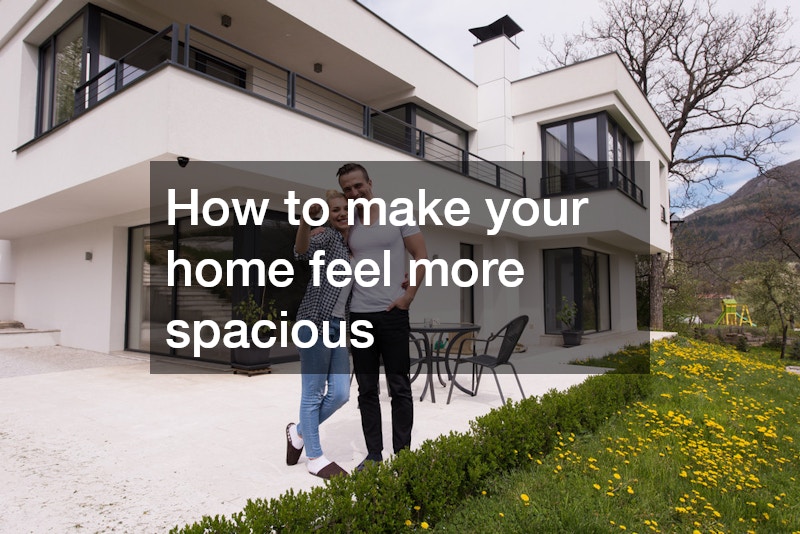Many people want to make their home feel bigger for various reasons. You may want to make your home feel larger because of a growing family or to add more functionality. Or you might just want to create an open, relaxing atmosphere. It can be difficult to make your home seem more spacious, especially if it’s the first time. With some strategic planning, you can turn your home into a comfortable, spacious space. Here are some practical tips that will help you reach this goal.
Light colours on your walls
Paint your walls in light colors. This is one of the easiest ways to make your house appear larger. Light colors such as pale grey, soft white, and pale blue can reflect the natural light to create an illusion of more space. These colors also give your interiors a feeling of calm and airiness.
If you are worried that white walls will appear too sterile in your home, use off-whites or cream tones. While adding warmth and personality, these colours still retain the benefits of white in terms of enhancing space. Choosing matte or satin finishes will help diffuse the light and make your room appear brighter.
Use a monochromatic color scheme to add character by pairing light-coloured furniture and decor with walls. This will create a seamless and cohesive look in your home, which will increase the feeling of spaciousness.
Create an outdoor living area
A patio or deck can add a lot of space to your home. You can create additional space for dining, relaxation or entertainment by extending your indoor living area outdoors.
Choose materials that compliment your home’s architectural design and climate. Timber decking is popular due to its durability as well as aesthetic appeal. Pergolas and retractable awnings are popular choices for homeowners who want to use their outdoor space all year round.
Additions such as outdoor furniture, potted flowers, and ambient lighting will elevate the area. An outdoor space can be used as an extension to your home when it is designed well. It gives you more space to entertain and enjoy.
Decluttering and simplifying
Untidy homes make them appear smaller. Decluttering is more than simply tidying up. It requires you to evaluate what you love and need versus what’s just taking up space.
Sort your items into four categories: Keep, Donate, Sell, and Discard. Don’t hesitate to get rid of items that you haven’t used for years or no longer serve any purpose. To keep your essentials neatly hidden, invest in storage solutions like built-in cupboards, under-bed storage and multi-functional furnishings.
Adopt the “one-in, one-out” rule to maintain a clutter free environment: remove one item for each new one you bring into your house. Keep surfaces clean and organized to make your room feel spacious and welcoming.
Maximise Natural Light
Natural light can make a huge difference in creating an airy, spacious feeling. To let in the most light, make sure your windows are free of obstructions and clean. Lightweight fabrics or sheer curtains will allow the sunlight to pass through.
If your budget permits, consider installing skylights or additional windows. Even small changes can increase the amount of light in a room. For example, replacing solid doors with glass-panelled ones.
Mirrors strategically placed can help to increase natural light in your home. Mirrors reflect light, which makes spaces seem larger and brighter. Mirrors should be placed opposite windows or light sources to achieve maximum effect.
Mirrors – Strategically Using Them
Mirrors can be a very powerful tool for interior design. They are especially useful in creating the illusion of space. Mirrors, when strategically placed, can double the size of any room.
Mirrored furniture or large wall-mounted mirrors work well in bedrooms and living rooms. A series of small mirrors in narrow hallways can give the illusion of depth. Consider a mirror that is frameless and spans the entire width of the vanity in bathrooms to increase the brightness and space.
Try out different styles and shapes to find the right fit for your aesthetic. For example, round mirrors add a modern, soft touch while rectangular mirrors with a large size make a bold, bold statement.
Raise Blinds and Curtains
The illusion of higher ceilings is created by hanging curtains or blinds above the tops of windows. This makes the room appear larger. Curtain rods should be installed closer to the ceiling than above the window frame.
To enhance the natural flow of light, choose lightweight or sheer fabrics. Consider layering sheer drapes with heavier drapes at night to provide privacy. Curtains with vertical stripes or patterns can help to accentuate your window and wall height.
Choose Multi-Functional furniture
Multi-purpose furniture is an excellent way to maximize your space. You can find items like ottomans that have built-in storage or extendable dining tables and sofa beds. These pieces will allow you to maximize your space without sacrificing style or comfort.
Choose furniture with exposed legs and a slim profile for a feeling of spaciousness. Avoid large or bulky furniture, which can make the room feel cramped.
Keep flooring consistent
The same flooring throughout your house creates a seamless flow, which makes the space feel bigger. Consistency is important, whether you choose polished concrete, laminate or timber.
Try to stick to the same color palette if you have to use different types of flooring. This minimizes visual breaks, and keeps the look cohesive. Rugs can be strategically used to create zones in open-plan spaces without disrupting the flow.
Create Open Storage Displays
Open shelving, when designed thoughtfully, can create a feeling of space. Displaying books, decorative items, and plants can add visual interest to the room without overpowering it.
Avoid overcrowding your shelves and stick to a consistent colour scheme. A glass-front cabinet is another way to showcase items and keep them dust-free.
Vertical Space
Install tall bookcases, cabinets, or storage that hangs. This will draw the eye up and give the illusion of higher ceilings. Vertical gardens and wall-mounted plants can add greenery to your home without taking up valuable space.
Use magnetic strips or wall-mounted racks to store utensils in the kitchen. It keeps the countertops clean and organised, while also adding a design element.
Rearrange your Furniture
Rearranging furniture can sometimes make a big difference to the feeling of space in your home. Avoid blocking windows or pathways with large furniture. Arrange items in a way that creates an open flow, and draws attention to focal points like a fireplace or artwork.
Furniture that is positioned away from walls creates a dynamic and inviting design. Try out different arrangements to see what works for you.
Smart Storage Solutions: Invest in them
Storage is key to maintaining an organized and spacious home. Storage solutions, such as built-in closets, under-stair cabinets or hidden compartments can maximize every available centimetre.
Use organisers for smaller items such as trays, baskets or drawer dividers. This will keep them neat and easily accessible. Labeling storage containers will help you keep things in order and find the items that you need.
Add Greenery
Plants can help your home feel more spacious and fresh. Indoor plants should be chosen according to your maintenance level and lighting conditions. Vertical gardens, slim potted plants or hanging plants are great options to add greenery and save space.
Plants can not only improve the air quality in a room, but they also create a calmer environment. For a balanced visual display, group plants in odd-numbered groups and vary the height of each plant.
The Bottom Line
It doesn’t take extensive renovations to make your home seem more spacious. These practical tips will help you create an open, comfortable and welcoming environment. Small changes, whether it is through the strategic use of lighting, clever furniture choices, and clever storage solutions can make a huge difference. You can make your home feel larger, brighter and more functional with a little creativity and effort.



